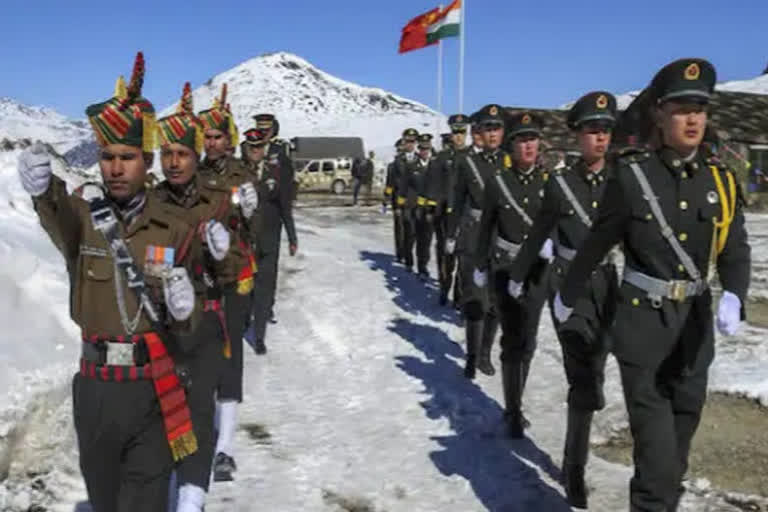Hyderabad: Amid ongoing tensions with China along the Line of Actual Control (LAC), India has ramped up its day and night surveillance of border areas in Arunachal Pradesh using a fleet of state-of-art radars and UAV's (Unmanned Aerial Vehicles). The Indian Army is determined to give a strong retort to China's military adventurism at the border areas.
Post the deadly clash at Galwan Valley in 2020, the army has focused on enhanced surveillance at the border. In order to strengthen military preparedness in strategic locations, the armed forces are reinforcing technology and appropriate equipment to get minute-by-minute information from Eastern sector of Arunachal Pradesh. Instead of deploying forces, the army thinktank believes that it is crucial to track the enemy's movements. In fact, the army's stance changed completely after the Galwan face-off, now it is prepared to meet any eventuality if the need arises. Shunning the defensive-strategy, the army is ready to take the battle to the enemy.
The army has allocated 10,000 additional troops and immense firepower to the Mountain Strike Corps to help them carry out offensive operations along the Eastern stretch, besides alerting all Forward Operating Bases(FOB). Meanwhile, it has strengthened its border surveillance with state-of-art radars and UAV's(Unmanned Aerial Vehicles). As part of battle preparedness, the army has set up underground warehouses to store food supplies, ammunition, and oil for long term needs. Factoring weather conditions, the army has ramped up stocks of essentials for six months to avoid a cut in supply chain during winter. Also the army is battle-ready for harsh weather conditions in the crucial Eastern stretch which runs 1,346 km along the Line of Actual Control (LAC).
After securing the border from within, the army top brass are banking big on aviation to monitor movements beyond the LAC. The Aviation Division, which is specially set up to monitor movements beyond the LAC, is currently monitoring every activity. Cheetah, Dhruv, and Mac3 Rudra helicopters designed with indigenous technology, and the UAV Heron 1 imported from Israel are being used for this purpose. The Heron 1 UAV has a range of 250 kilometers line-of-sight and has a wind resistance of 20 kilometers during the day, and 15 kilometers during the night. Control rooms specially set up at Missamari and Rupa, are compiling surveilled information to make appropriate decisions. In addition, the forces are using Cheetah for small scale aerial surveillance, Dhruv for supplying food and weapons to troops operating at the border, and armed Rudra helicopters for military attacks when necessary.
Read: Top Army commanders to review India's security challenges, situation along LAC
Adding to it, the Army is in constant touch with the Indian Air Force. The Eastern Command forms a large part of the Indo-China border at Arunachal Pradesh. Within this area, the Army has deployed a large number of ultralight field howitzers at high altitudes, and set up state-of-the-art radars and long-range surveillance cameras. The Army has developed its own surveillance technology that captures millions of images, and alerts the forces when there are abnormal movements. As a part of modern war strategy, the Army is planning to set up a new system called Integrated Battle Group (IBG) specifically integrating the armed forces, artillery, intelligence and technology, and supplies sectors. The latest addition to the Army, the heavy-lift Boeing Chinook helicopter, has been carrying troops, weapons, and artillery, evading enemy radars.
In order to be prepared for a face-off with the enemy, one needs to watch their every move, and predict the next. With the ever-changing war strategy, it is important to know what is happening across the border, and be prepared to respond any moment. The Indian Army, with its state-of-art technology, has been specially surveilling China’s movements at the border. Alongside improving the roadway facilities, the Army is intensifying surveillance and combat readiness. How is the command control center set up at Rupa military base working to detect enemy movements? What is its strategy? Navneet, Deputy Commandant of Aviation, spoke with Eenadu about their plans. “The Indian Army is all set for a face-off if China attempts any transgression. We are surveilling every movement across and beyond the Line of Actual Control (LAC) besides deploying large number of troops in strategic locations and utilizing latest technology and equipment."
The Eastern Army Command has made it amply clear that it is ready for a face-off with China. Though India would prefer to extend an olive branch to its neighbour to maintain peace and harmony, the recent skirmishes at the border have made it watchful. Manoj Pande, Eastern Army commander, said that the military operations between the two nations have increased over the past few years, and that India has ramped up all terrain vehicles, weapon system integrated helicopters, radars, and night vision cameras at the border. He said that the focus was on enhancing surveillance rather than on deploying more forces. He added that necessary technology is in place in the Eastern Command, and that informed decisions are made on the basis of data relayed through long-range drones and surveillance cameras.
In fact, Manoj Pande has objected to constructions in ecologically sensitive areas near the LAC, and stressed that India has always acted in accordance with the existing agreements. On war-preparedness, he said, "We have stocked up supplies of ammunition and food and ready for any eventuality. The addition of integrated battle groups (IBG) to the troops is likely to happen. We are preparing to deploy Mountain Strike Corps and introduction of Chinook to armed forces has facilitated the movement of troops and arms in the Eastern Command. Ultra-light howitzers were deployed in key areas and Chinook helicopters would aid during strategic airlift operations," he added.



